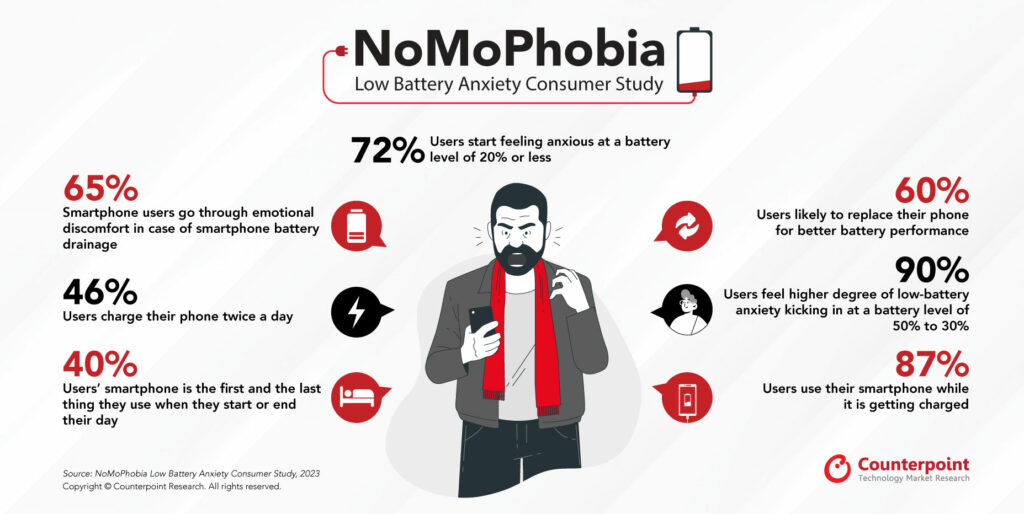Trends
72% of smartphone users experience low-battery anxiety
As many as 65% of smartphone users in India go through emotional discomfort due to battery drainage, according to a consumer study by Counterpoint Research. Further, 72% of the survey respondents start experiencing low-battery* anxiety at a battery level of 20% or less.
Counterpoint Research conducted a survey among smartphone users in India to understand the emotions they experience in the event of battery drainage. The study highlights the factors and instances that reflect low-battery anxiety in people’s everyday routines and lifestyles. It also captures how people try to deal with low-battery anxiety.
The study divides the discomfort emotions experienced due to low-battery anxiety into six categories – (1) Worried/Anxious (2) Disconnected (3) Helpless (4) Fear of missing out (FOMO) (5) Nervous (6) Unsafe. Among these, “Worried/Anxious” is the emotion experienced the most with 28% of the respondents ticking the choice. Further, for 9 out of 10 users, a higher degree of low-battery anxiety kicks in at a battery level of 30% to 50% when compared to the 0%-30% level.
40% of the respondents use their smartphones the first thing in the morning, as soon as they wake up, and the last thing before they go to bed. 42% of the respondents use smartphones most for entertainment, where social media is at the top. Further, 87% use their phones while they are being charged, and two-thirds use their phones even while they spend time with family or are working/studying. As a result, most people charge their phones multiple times daily, with 46% charging twice a day.
Commenting on low-battery anxiety, Research Director Tarun Pathak said, “We carry our world in our pocket via smartphones. From entertainment to official work to connecting with others, our smartphones execute almost everything for us. As a result, people have developed a phobia of not being able to use their phones. Further, social media being the top activity for which smartphones are used, people have this fear of missing out on things around them. That is why most people keep searching for charging opportunities and end up feeling anxious and worried about the thought of running out of battery and not being able to use their smartphones. The feeling of low-battery anxiety is the highest in the working age group of 31-40 followed by the 25-30 age group.”

On dealing with low-battery anxiety and NoMoPhobia (no-mobile phobia), Senior Analyst Arushi Chawla said, “Most people (92%) use the smartphone’s power-saving mode to ensure longer use of their device during the day, while 64% of them switch on the power-saving mode when the battery level is 20% or less. Further, 50% use a power bank, among which more than one-third use it at least once a day.”
Chawla added, “NoMoPhobia has made people decide their charging patterns accordingly. It is interesting to observe that most people depend on in-built device options like power-saving mode to ensure a longer battery life daily. Also, given the dependence people have on their phones, many (65%) limit the use of their phone to save battery for more crucial times, while 82% cut down the use of social media applications like Instagram, LinkedIn, Twitter and Facebook to save battery. Therefore, the battery is a key buying factor when purchasing a smartphone. 60% of the respondents are likely to replace their current smartphone for better battery performance.”
With the fear of not being able to use one’s smartphone on the rise, innovation as well as improvisation around smartphone battery life and longevity is an aspect that can’t be ignored.
CT Bureau














You must be logged in to post a comment Login